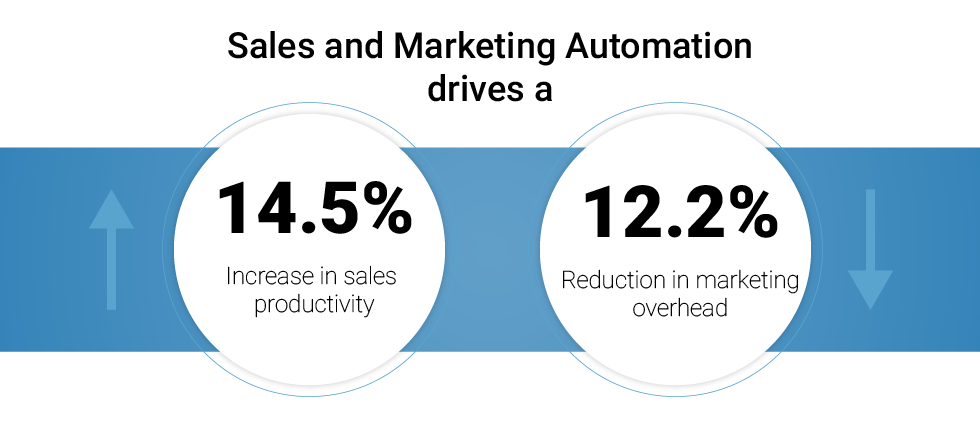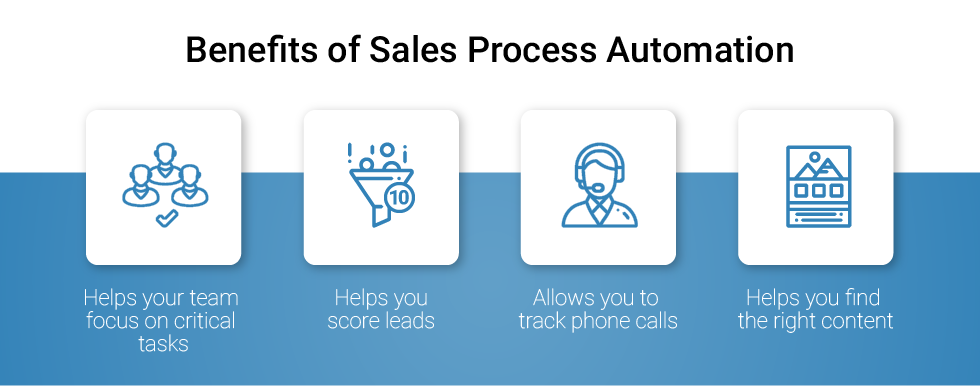In 1968, movie viewers were introduced to Hal 9000, the “intelligent” computer that traveled to the moon with a crew of astronauts in 2001 Space Odyssey. The film never won any Oscars, but the 1968 Hal did introduce the public to the notion that perhaps computers could be programmed with intelligence, analyze situations, and hold conversations with humans.
Fast forward to 2020. Computers indeed can be programmed to be “intelligent,” that is, they can learn and organize information and data. Businesses can thus make decisions more “smartly.” We call this artificial intelligence (AI).
When we combine AI with labor-saving technology (automation), we have a marriage that can transform sales CRM. Let’s unpack all of this so that you can see the uses and value that AI and automation actually bring.
Table of Contents
Just What is Sales Process Automation in CRM?
In brief, sales process automation is the use of software to conduct and streamline sales tasks that were formerly conducted manually – management of contact with customers/potential customers, order processing, inventory control, order tracking, post-sale customer management, and more. Sales process automation as it relates to customer relations management is obvious. The customer is involved and must be satisfied through the entire process of purchasing and beyond.
Let’s take a simple sales process automation example. John has been “courting” a customer for a bit and moving that customer through the sales funnel. John is in an accident, has surgery, and will be out for a while. Who now manages that customer and how? Maybe John has some notes somewhere? Maybe we can call John in the hospital and get some valuable information? Call center automation eliminates such issues. All of John’s history, conversations, and notes with this customer have been automated, that is, exists within a database so that a replacement salesperson can review everything and pick up, not missing a beat.

In fact, recent research shows that when salespeople have full data accessibility, their sales cycles are shortened by 8-14%.
Today’s Consumer Demands Sales Automation
Consumers won’t continue to patronize a business that makes them wait for answers, that does not consider their needs paramount, and that does not deliver efficiently.
Businesses understand this and have put into place a number of automated systems for CRM – voice-responsive bots to direct calls to the right department, chatbots on websites, and self-service customer service whenever possible.
And no matter which salesperson or customer service rep a customer contacts, there is a full history of all interaction with that customer that can be accessed – all on one screen. This Sales Automation in CRM is now just standard.
Putting AI into the Mix
Sales automation CRM has resulted in huge databases of information and data – a treasure trove of potential insights into customers – actual and potential. But much of this exists in individual units.
What if a business could churn all of this information to answer some larger questions – questions such as what are the most frequent customer questions about our products? What are the most common pain points of our customer base? What are the most frequent post-sale issues our customers raise? Where do our customers most frequently “bottleneck” in our sales funnel? Can future buyer behavior be predicted based upon current behavior? This is where conversation intelligence technology for sales comes into play. It can churn all of those individual units of information and present the big picture to businesses.
This is where AI comes into play. It can churn all of those individual units of information and present the big picture to businesses.
Here’s another simple example. All of us have shopped on Amazon at one time. Once we purchase a product, what happens? We are presented with more purchasing options, with the phrase, “Other customers who purchased this item also purchased…,” and then we are shown more products. This is known as “upsell,” and it is fully based upon the information that AI has provided to Amazon.
AI and Automation are No Longer Just for the “Big Boys”
Until recently, only large enterprises could afford the kind of data science that Amazon uses. But now, there are sales process automation tools, also incorporating AI, that small and mid-sized businesses can use to achieve the same objectives.
This access to automation sales technology allows smaller businesses to compete in the broader market place that large enterprises have pretty much dominated until now.
All of the Possibilities of AI + Automation for Sales
While all of these may not apply to you at this point, it is nice to know that these are the possibilities:
-
- Transcribe and Then Analyze Customer Interactions. Every interaction, whether by email, text, use of a chatbot, or phone call can be transcribed and stored. This becomes a huge repository of data, that can be analyzed via AI, based upon specific searches or questions. Out of these searches and questions will come trends that can drive decisions on important CRM activities that must be in place. It can also analyze which sales practices give good results and which do not.
- In-Call voice Analysis. Yes, it’s possible. Based on the machine learning aspects of AI, a customer’s voice and words can be analyzed for types and levels of emotion. This information can be delivered in real-time, and make recommendations to sales reps and customer support agents as to how to proceed with the interaction. “Let the customer vent” may be a typical recommendation.
- Sales Process Automation/AI Can Engage and Nurture Leads. Consider just email as a venue, for example. There are tools when coupled with automated segmentation, that can provide a variety of email messages, based upon where a customer may be in the sales funnel and what AI has determined to be the best verbiage, and even times of day to send an email, based upon past customer behavior and successful closes.

Sales Process Automation - Churn and Analyze Support Tickets to Identify Trends and Recommend Responses. The conversational interaction that occur between customers and support agents hold a huge amount of data. When all of these interactions are stored with automation, AI can step in and churn all of this data. Companies will then be able to:
- Identify the most common questions, issues, and needs
- Identify the most successful types of responses to these commonalities
- Provide recommendations on which issues can be resolved with a “canned” response and which need a more personal touch.
When AI is used in these circumstances, businesses can establish consistency in their responses to customers and have the data they need to train their sales staff.
Kristen Savage, Customer Support Director for Grab My Essay, puts it this way: “We are in the business of producing customized products for our customers. New customers have lots of questions; current customers want changes to their products. And we have to nurture both current and potential customers by responding to their requests, questions, and problems quickly and well. AI has provided us with the types of questions and issues we can place on an FAQ page; we have chatbot services that can respond well to questions of visitors and new users, and then we have staff that will personalize more complex issues. Overall, it works really well. We are consistent in our treatment of customers, and we have lowered our costs significantly.”
Check out your potential cost savings by implementing a chatbot solution for customer supportCalculate ROI
- Lead Scoring Becomes a Scientific Process. When AI is added to CRM automation, the potential for leads to become actual customers can be scientifically determined. AI can use all of the demographic information on past customers so that salespersons can compare it with their current leads and know exactly where to place their priorities in nurturing among those prospects. Spending time with leads who will probably not eventually buy is inefficient and a waste of valuable time. Those with low scores can be placed on the back burner, should time allow at some point in the future.

Sales and Marketing Automation Facts - Improve Content ProductionInbound marketing relies upon content – content that is published on a website, via emails, in a blog, all over social media, and even on forums and publications of influencers in a specific niche.The challenge becomes one of not just reaching this customer base where they are (and data science now provides that information), but also creating the type of content that will resonate with an audience.
Also read:Chatbots and Conversational Marketing.
The data that is gathered through interactions with customers, with the proper analytics, will provide reams of information on the type of content, the language and style, and where an audience is most accessing that content. Using a tool such as Wordsmith will garner this data and make recommendations. Then it is just a matter of using that data to actually create the content. Many small and mid-sized businesses turn this data over to outsourced writing professionals, either through writing services such as Trust My Paper or Studicus, or using freelancers with the right experience and successful histories. Again, gathering data through automation and then adding AI to churn it, results in the right content at the right time, and in the right places.
- Sales Training Based Upon ScienceNumbers don’t lie. There are sales pros who vary a lot in their success rates, and these have always been tracked manually. And often, the successful ones are used to train new hires. This is a good option, but there is a more scientific method to onboard new hires. Using AI, along with process automation that tracks successful sales performance, will provide a clear picture of successful sales behaviors. These can then drive the training processes and activities for onboarding.

Benefits of Sales Process Automation
In the End…
Salespersons are employed to make sales. Asking them to manually track all of their customer interactions, their successes, and failures, and to make conclusions for themselves poses two problems – they are being asked to engage in activities that are not directly related to sales, and they are working without the benefit of the knowledge of all of their team members combined.
When automated CRM is married to AI, all sales staff have access to the big picture and can use the analysis and recommendations to boost their own performance and company ROI.
Let us help you connect your brand with customers where they communicate today. Chat or voice.






